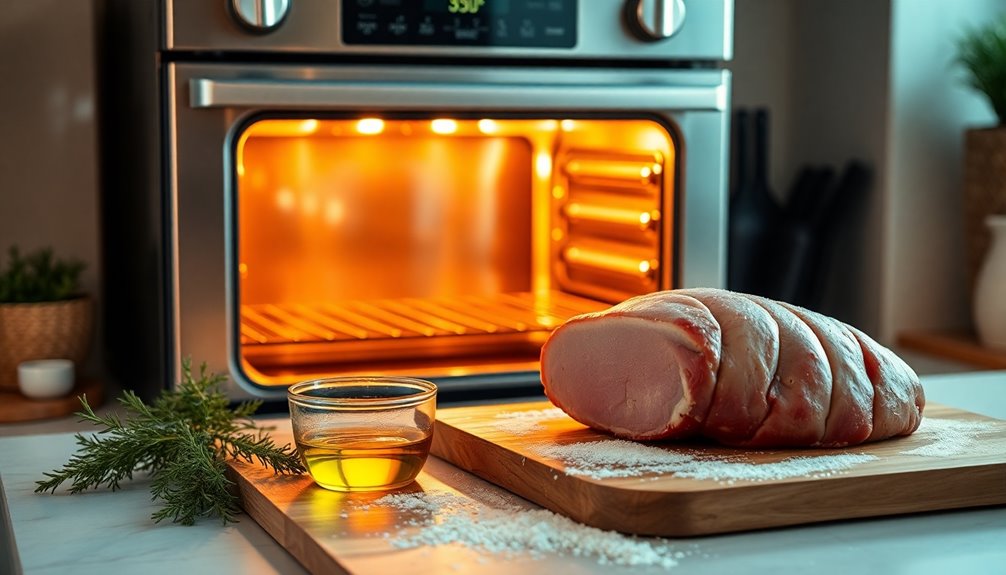To make a delicious pork roast, start with a 4-5 pound shoulder or loin. Preheat your oven to 350°F (175°C) and season the pork with salt, pepper, garlic, and fresh herbs like rosemary and thyme. Sear the roast on all sides for 3-4 minutes to lock in flavor. Place it in a roasting pan, add chicken broth, and baste every 20-30 minutes. Cook until the internal temperature reaches 145°F. Let it rest for about 10 minutes before slicing. Pair it with your favorite sides to make it special. There's plenty more about flavors and techniques to explore!
Key Takeaways
- Select a 4-5 pound pork roast, preferably shoulder or loin, for optimal flavor and tenderness.
- Season the meat with olive oil, minced garlic, fresh rosemary, and thyme for aromatic depth.
- Sear the pork on all sides for 3-4 minutes to lock in flavors before roasting.
- Roast in a preheated oven at 350°F, basting with chicken broth every 20-30 minutes until reaching an internal temperature of 145°F.
- Let the roast rest for 10 minutes after cooking to redistribute juices before slicing and serving.
History

When you think about pork roast, you mightn't realize it has a rich history that dates back centuries.
Originating in various cultures, this dish has evolved through time, adapting to different culinary traditions. Ancient Romans celebrated feasts featuring pork, highlighting its importance in their diet.
As you explore further, you'll notice that in medieval Europe, roasting became a popular cooking method, often associated with special occasions.
In Asia, pork holds a significant role in festivals and family gatherings, symbolizing prosperity.
Each region has its own unique spin on pork roast, reflecting local ingredients and flavors.
Understanding this background enriches your appreciation for the dish, making each bite a connection to the past.
Recipe

Pork roast is a classic dish that brings warmth and comfort to any dining table. With its crispy skin and tender, juicy meat, a well-cooked pork roast can be the centerpiece of a memorable family meal or a festive gathering. The key to a perfect pork roast lies in the choice of meat, temperature control, and seasoning. This recipe will guide you through the process of creating a flavorful and succulent pork roast that's sure to impress your guests.
To achieve the best results, it's vital to let the pork roast come to room temperature before cooking. This helps the meat cook evenly and retain its juices. Additionally, using a meat thermometer guarantees that you achieve the desired doneness without overcooking. With a few simple ingredients and some patience, you'll be able to create a delicious pork roast that everyone will love.
Ingredients:
- 4-5 pounds pork roast (shoulder or loin)
- 3 tablespoons olive oil
- 4 cloves garlic, minced
- 2 tablespoons fresh rosemary, chopped
- 2 tablespoons fresh thyme, chopped
- 1 tablespoon salt
- 1 teaspoon black pepper
- 1 cup chicken broth
- Optional: vegetables for roasting (carrots, potatoes, onions)
To cook the pork roast, preheat your oven to 350°F (175°C). In a small bowl, mix the olive oil, minced garlic, rosemary, thyme, salt, and black pepper to create a marinade. Rub this mixture all over the pork roast, making sure it's well-coated.
Place the roast in a roasting pan, and if desired, surround it with chopped vegetables. Pour the chicken broth into the pan to keep the meat moist during cooking. Roast in the preheated oven for approximately 25 minutes per pound, or until the internal temperature reaches 145°F (63°C).
Once cooked, let the roast rest for at least 15 minutes before slicing. When cooking a pork roast, remember that resting the meat is vital as it allows the juices to redistribute, resulting in a more flavorful and moist dish.
Additionally, consider experimenting with different herbs and spices to customize the roast to your taste. For a crispy skin, you can increase the oven temperature for the final 15-20 minutes of cooking. Finally, save the drippings from the pan for a delicious gravy that can elevate your pork roast experience even further.
Cooking Steps

To get started, you'll want to preheat your oven to 350°F.
Next, season the pork generously to enhance its flavor.
Once that's done, it's time to sear the pork on all sides for a nice crust.
Step 1. Preheat Oven to 350°F

Start by preheating your oven to 350°F. This temperature is ideal for cooking a pork roast, ensuring it cooks evenly and remains juicy.
While the oven heats up, take a moment to prepare your roasting pan. If you have a rack, place it inside the pan to allow for proper air circulation around the meat. This will help achieve that perfect golden-brown crust.
Check your oven's indicator light or thermometer to confirm it's reached the desired temperature. Once it's ready, you're set to move on to the next step in your pork roast journey.
Step 2. Season the Pork Generously

Once your oven is preheated, it's time to elevate your pork roast with a generous seasoning.
Start by patting the pork dry with paper towels; this helps the seasoning stick better. Next, sprinkle salt all over the roast, making sure to cover every nook and cranny. Don't be shy—seasoning is key to enhancing flavor!
Follow up with freshly cracked black pepper for a bit of heat. You can also add garlic powder, onion powder, or your favorite herbs like rosemary or thyme for extra depth.
Rub the spices into the meat, ensuring an even coat. Let the seasoned pork rest for about 15 minutes before cooking; this allows the flavors to meld beautifully.
Happy cooking!
Step 3. Sear Pork on All Sides

Before you move on to roasting, searing the pork on all sides is essential for locking in flavor and creating a beautiful crust.
Start by heating a heavy skillet or Dutch oven over medium-high heat. Add a tablespoon of oil and let it heat until shimmering.
Carefully place the seasoned pork in the hot pan, ensuring it doesn't overcrowd. Sear each side for about 3-4 minutes, turning until you achieve a rich, golden-brown crust.
Don't forget the edges; use tongs to hold the pork upright if necessary.
Once seared, remove the pork from the pan and set it aside. This step not only enhances the flavor but also prepares the meat for the next stages of cooking.
Step 4. Baste With Broth Regularly

After searing the pork to perfection, it's time to keep that flavor locked in by basting with broth regularly.
Use a ladle or spoon to drizzle the broth over the pork every 20 to 30 minutes during cooking. This not only keeps the meat moist but also enhances its flavor.
If you've got aromatics like garlic, rosemary, or thyme in the broth, it'll infuse the pork with even more deliciousness.
Make sure to use the drippings from the roasting pan, as they carry all those rich, caramelized flavors.
Keep an eye on the liquid level; if it starts to dry out, add more broth to prevent the pork from drying out.
Consistent basting is key to a juicy roast!
Step 5. Check Internal Temperature (145°F)

To guarantee your pork roast is perfectly cooked, checking the internal temperature is essential. Use a reliable meat thermometer and insert it into the thickest part of the roast, avoiding any bones.
You're aiming for an internal temperature of 145°F. Once the thermometer reads this temperature, your pork is safe to eat and will be juicy and tender. If it hasn't reached 145°F yet, continue cooking and check again in a few minutes.
Remember to let the roast rest for about 10 minutes after removing it from the oven; this allows the juices to redistribute, enhancing flavor. Following these steps ensures you serve a delicious pork roast that everyone will love!
Final Thoughts

As you wrap up your pork roast journey, remember that the key to a delicious meal lies in both preparation and patience.
You've selected the perfect cut, seasoned it well, and monitored that internal temperature.
Now, let the roast rest to lock in those juices before slicing. This step is vital for achieving that tender, mouthwatering result you crave.
Don't forget to serve it with your favorite sides; the right accompaniments can elevate your dish even further.
Whether it's a special occasion or a cozy family dinner, your effort will shine through.
So, gather your loved ones, share a meal, and enjoy the fruits of your labor.
You've earned it—bon appétit!
Frequently Asked Questions
What Type of Pork Is Best for Roasting?
When you're deciding on the best type of pork for roasting, consider options like pork loin, shoulder, or tenderloin.
Pork loin offers a lean and tender cut, while shoulder provides rich flavor and tenderness when cooked slowly. When preparing pork loin, it’s important to sear it first to lock in moisture, ensuring a juicy result. On the other hand, the shoulder cut benefits from low and slow cooking methods, which allow the flavors to meld beautifully and the meat to become fall-apart tender. For those experimenting with pork tenderloin cooking tips, remember to marinate the meat to enhance its natural flavor and consider using a meat thermometer to achieve the perfect doneness.
Tenderloin is another great choice, known for its juiciness.
Each cut has its unique qualities, so think about your taste preferences and cooking method to pick the one that'll satisfy your cravings perfectly.
How Long Should I Marinate the Pork Roast?
You should marinate the pork roast for at least 4 to 12 hours for the best flavor.
If you can, overnight is even better, as it allows the marinade to penetrate the meat more thoroughly.
Just make sure to keep it in the refrigerator while marinating to prevent any bacterial growth.
After marinating, you'll notice a significant difference in taste and tenderness, enhancing your overall dish.
Enjoy the delicious results!
Can I Cook a Pork Roast in a Slow Cooker?
Absolutely, you can cook a pork roast in a slow cooker!
It's a fantastic way to achieve tender, flavorful meat. Just season your roast, add some broth or marinade, and let it cook on low for several hours.
You'll want to check the internal temperature to guarantee it's safe to eat. The slow cooking process breaks down the meat fibers, making it juicy and delicious.
Enjoy the ease of this method!
What Side Dishes Pair Well With Pork Roast?
When you're thinking about side dishes, consider flavors that complement the main dish.
Roasted vegetables, like carrots and Brussels sprouts, add a nice touch. Mashed potatoes or creamy polenta provide a comforting base.
You might also enjoy a fresh salad with a tangy vinaigrette to balance the richness.
Don't forget about apple sauce or a fruit chutney; they can really enhance the overall meal experience with their sweetness.
How Do I Store Leftover Pork Roast?
To store leftover pork roast, you'll want to let it cool down to room temperature first.
Then, wrap it tightly in plastic wrap or aluminum foil, or place it in an airtight container to keep it fresh.
Make sure to refrigerate it within two hours to prevent bacteria growth. It should last about three to four days in the fridge.
For longer storage, consider freezing it; just make sure to label it!










